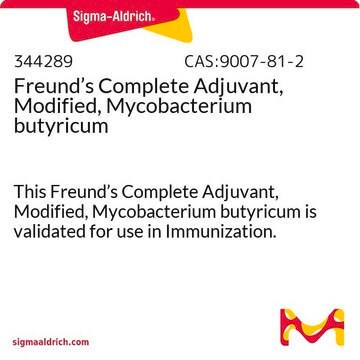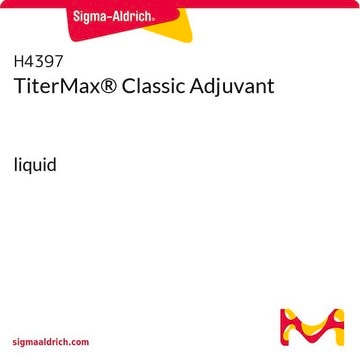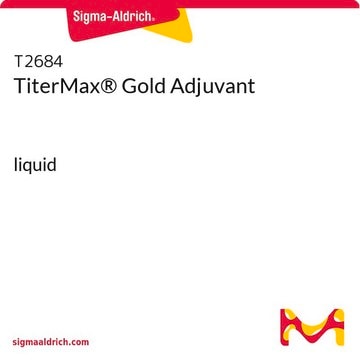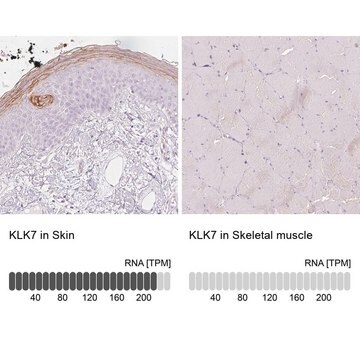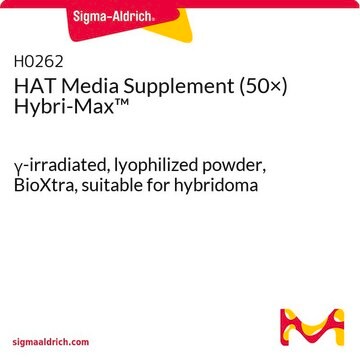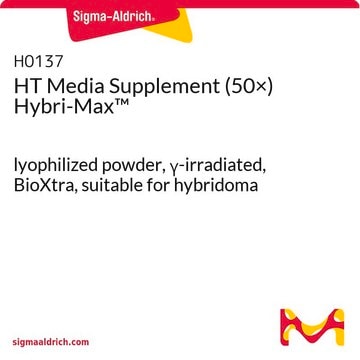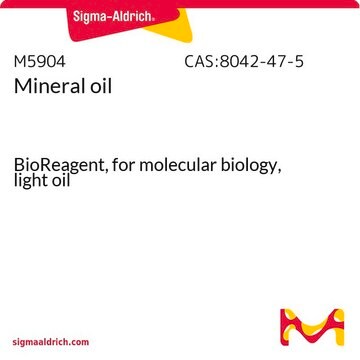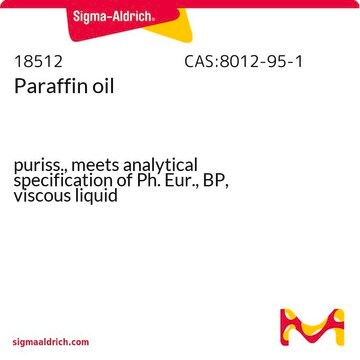344291
Freund′s Incomplete Adjuvant, Modified
Freund’s Incomplete Adjuvant, Modified Contains 85% Drakeol 5NF, 15% Arlacel A. Heat sterilized. Contains zero colony forming units.
Sinônimo(s):
Incomplete Freund′s Adjuvant
Faça loginpara ver os preços organizacionais e de contrato
About This Item
Código UNSPSC:
41116133
NACRES:
NA.41
Produtos recomendados
Nível de qualidade
forma
liquid (oily)
fabricante/nome comercial
Calbiochem®
condição de armazenamento
OK to freeze
cor
yellow
Condições de expedição
ambient
temperatura de armazenamento
10-30°C
Descrição geral
Contains 85% Drakeol 5NF, 15% Arlacel A (mannide monooleate emulsifier). Heat sterilized. Contains zero colony forming units/ml.
The word "adjuvant" is derived from the Latin, adjuvare, meaning "to help." During immunization, an adjuvant is generally mixed with the antigen to enhance the rate and amount of antibody formed. The most popular complete adjuvant is that of Freund. It consists of killed and dried microbial cells suspended in an emulsifying oil. Adjuvant without the microbial cells is called "incomplete adjuvant." Complete adjuvant forms a stable water-in-oil emulsion with aqueous solution of antigen. When injected subcutaneously into animals, the emulsified antigen forms a depot from which antigen is delivered slowly and at sustained levels to the animal′s antibody-synthesizing system. The induced antibody response is usually high and sustained. In guinea pigs, an additional benefit from adjuvant is the delayed appearance of hypersensitivity.
Componentes
10 ml of Freund′s Incomplete Adjuvant homogenized in the following amounts by weight:
85% Drakeol 5 NF (light mineral oil)
15% Arlacel A, mannide monooleate emulsifier
85% Drakeol 5 NF (light mineral oil)
15% Arlacel A, mannide monooleate emulsifier
Advertência
Toxicity: Standard Handling (A)
Nota de preparo
1. Take the vial of Friend′s Incomplete Adjuvant and fold the aluminum seal back to permit free access to the stopper. Be careful not to break the aluminum ring that holds the stopper in place.
2. Dissolve 50 mg of antigen in 5 ml sterile PBS, pH 7.0-7.3. Maintain or create sterility if at all feasible.
3. Draw the solution into a 10 ml syringe with a 1 inch 21 gauge needle.
4. Insert needle into adjuvant vial and forcibly drive solution into the vial. Withdraw about half the mixture into syringe and force it into the adjuvant vial again.
5. Repeat the mixing procedure in step 4 until a smooth, stable, milky, water-in-oil emulsion forms. Check if the emulsion is complete by expelling a drop from the syringe onto the water surface in a beaker. If the drop remains on the surface and does not disperse when the beaker is agitated slightly, the emulsion is adequate. A properly prepared emulsion is stable for days.
2. Dissolve 50 mg of antigen in 5 ml sterile PBS, pH 7.0-7.3. Maintain or create sterility if at all feasible.
3. Draw the solution into a 10 ml syringe with a 1 inch 21 gauge needle.
4. Insert needle into adjuvant vial and forcibly drive solution into the vial. Withdraw about half the mixture into syringe and force it into the adjuvant vial again.
5. Repeat the mixing procedure in step 4 until a smooth, stable, milky, water-in-oil emulsion forms. Check if the emulsion is complete by expelling a drop from the syringe onto the water surface in a beaker. If the drop remains on the surface and does not disperse when the beaker is agitated slightly, the emulsion is adequate. A properly prepared emulsion is stable for days.
Outras notas
10 ml of Freund′s Incomplete Adjuvant homogenized in the following amounts by weight:
85% Drakeol 5 NF (light mineral oil)
15% Arlacel A, mannide monooleate emulsifier.
1. Take the vial of Friend′s Incomplete Adjuvant and fold the aluminum seal back to permit free access to the stopper. Be careful not to break the aluminum ring that holds the stopper in place.
2. Dissolve 50 mg of antigen in 5.0 ml of sterile PBS, pH 7.0-7.3. Maintain or create sterility if at all feasible.
3. Draw the solution into a 10 ml syringe with a 1 inch 21 gauge needle.
4. Insert needle into adjuvant vial and forcibly drive solution into the vial. Withdraw about half the mixture into syringe and force it into the adjuvant vial again.
5. Repeat the mixing procedure in step 4 until a smooth, stable, milky, water-in-oil emulsion forms. Check if the emulsion is complete by expelling a drop from the syringe onto the water surface in a beaker. If the drop remains on the surface and does not disperse when the beaker is agitated slightly, the emulsion is adequate. A properly prepared emulsion is stable for days.
85% Drakeol 5 NF (light mineral oil)
15% Arlacel A, mannide monooleate emulsifier.
1. Take the vial of Friend′s Incomplete Adjuvant and fold the aluminum seal back to permit free access to the stopper. Be careful not to break the aluminum ring that holds the stopper in place.
2. Dissolve 50 mg of antigen in 5.0 ml of sterile PBS, pH 7.0-7.3. Maintain or create sterility if at all feasible.
3. Draw the solution into a 10 ml syringe with a 1 inch 21 gauge needle.
4. Insert needle into adjuvant vial and forcibly drive solution into the vial. Withdraw about half the mixture into syringe and force it into the adjuvant vial again.
5. Repeat the mixing procedure in step 4 until a smooth, stable, milky, water-in-oil emulsion forms. Check if the emulsion is complete by expelling a drop from the syringe onto the water surface in a beaker. If the drop remains on the surface and does not disperse when the beaker is agitated slightly, the emulsion is adequate. A properly prepared emulsion is stable for days.
Freund, J. 1947. Ann. Rev. Microbiol.1, 291.
Informações legais
CALBIOCHEM is a registered trademark of Merck KGaA, Darmstadt, Germany
Código de classe de armazenamento
10 - Combustible liquids
Classe de risco de água (WGK)
WGK 3
Certificados de análise (COA)
Busque Certificados de análise (COA) digitando o Número do Lote do produto. Os números de lote e remessa podem ser encontrados no rótulo de um produto após a palavra “Lot” ou “Batch”.
Já possui este produto?
Encontre a documentação dos produtos que você adquiriu recentemente na biblioteca de documentos.
Os clientes também visualizaram
Nossa equipe de cientistas tem experiência em todas as áreas de pesquisa, incluindo Life Sciences, ciência de materiais, síntese química, cromatografia, química analítica e muitas outras.
Entre em contato com a assistência técnica

